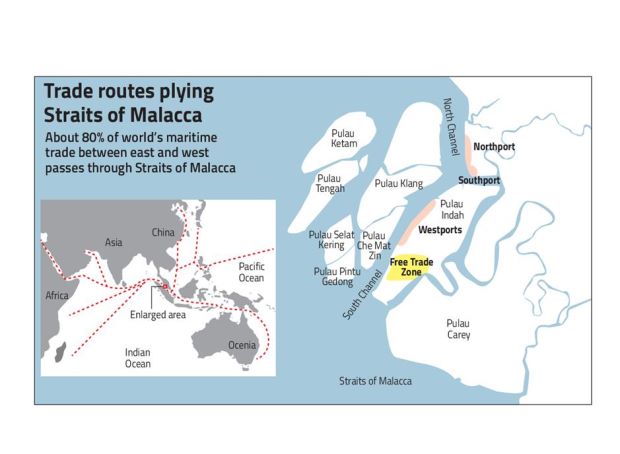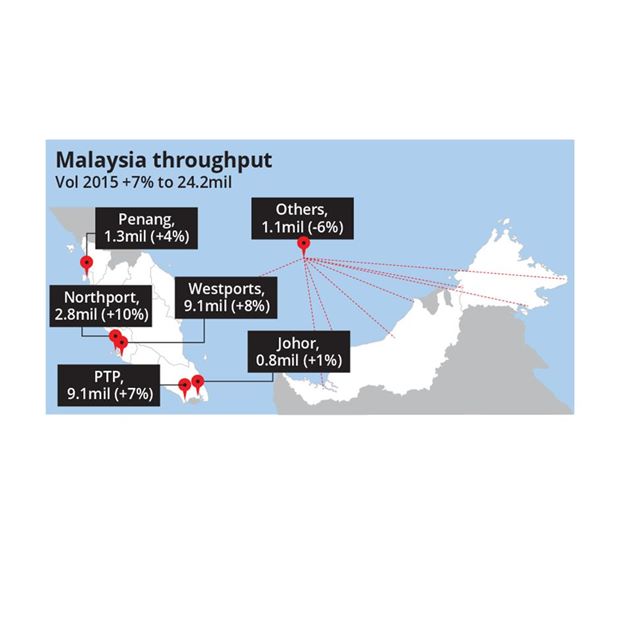The giant republic’s aggressive investments in ports and rail links in Malaysia under its belt-road regional economic expansion programme is going to change the outlook for the island republic.
CHINA’S current mega belt-road projects in Malaysia, once completed, will alter trade routes in the region and this may divert hundreds of billions worth of trade from Singapore, according to industry players.
Cargoes and goods within the region heading for China or vice versa could bypass the Port of Singapore, when China-funded ports and East Coast Rail Line (ECRL) in Peninsular Malaysia are completed within five to 10 years.
The double-track five-year ECRL project, scheduled to launch this year with soft loans from China, will cater for passenger and freight transport when construction by a Chinese state-owned company is completed.
It will connect ports on the east and west coasts of Peninsular Malaysia and will alter current regional trade routes, which ply between the busy Straits of Malacca and the South China Sea via Singapore.
Currently, Singapore is in a strategic position along the east-west route.

About 80% of the world’s maritime trade between east and west passes through the Straits of Malacca, and the strait is the main shipping channel between the Indian Ocean and the Pacific Ocean linking major Asian economies such as India, China, Japan and South Korea.
Singapore is the regional oil hub that captures oil tankers carrying an annual US$600bil (RM2.6tril) worth of the commodity and an important transhipment centre for the region. It is at the southern tip of the South China Sea, that sees an annual trade traffic to the tune of US$5tril (RM22tril) a year.
But China’s aggressive investments in ports and rail links in Malaysia – under its belt-road regional economic expansion programme – is going to change the outlook for Singapore.
This game changer will bring vast economic benefits and opportunities to Malaysia but will most likely exert negative impact on Singapore and force it to make adjustments to its future plans.
“This is a dream of a lifetime for Malaysia to eventually stop cargoes transiting through Singapore, with the generous inflow of direct investments and expertise from China now. In 10 years or so, Malaysia can say bye-bye to Singapore,” says a veteran port operator and logistics consultant with experience in Malaysia, Singapore and China.
The belt-road projects are part of China’s strategy to expand its economic activities and influence overseas, export its over-capacity, while at the same time, help the less developed nations to build infrastructure and connectivity to boost trade and economic development.
By participating in China’s string of belt-road projects, Malaysia’s economy, trade and logistics services will be further enhanced.

The port operator/consultant, who declines to be named, projects: “Transhipment cargoes in Singapore will be greatly reduced at a faster pace than before as the new ports will become more competitive and will have more sailing frequencies to key points.
“Port’s contribution to Singapore’s economy will be reduced and its attractiveness as a global transhipment hub will fade with the regional ports now having the capability to provide direct shipping services.”
In fact, PSA Singapore Terminals have seen a gradual decline in handling container cargo volume in recent years.
Last year, PSA Singapore Terminals handled 30.59 million TEUs of cargo containers or 0.1% less than 2015’s 30.62 million.
However, the island republic is still the world’s busiest transhipment hub, with excellent connectivity to 600 ports.
While the global economic slowdown has certainly contributed to the decline, there is talk that the China’s switch to Malaysian ports could be another factor.
In contrast, Port Klang continued to post a respectable increase in cargo volume. In 2016, container throughput of Port Klang posted an increase of 10.8% to 13.17 million TEUs.
Goh Bok Yen, urban land planning and transportation management consultant, believes that Kuala Lumpur could capture Malaysia-China indirect trade once the plan to hook up port and rail systems is operational.
In 2015, Malaysia-China’s indirect trade – largely through Singapore – was close to RM200bil.
“You can safely say that most of the indirect trade that went through Singapore would return to Malaysia as there is no necessity to use Singapore anymore in the future,” says Goh.
China is currently the biggest trading partner of Singapore, and Malaysia ranks second.
Projects with impact
While China is already involved in the building of the Gemas-Johor double-tracking railway, the most impactful project has to be the RM55bil ECRL.
The ECRL acts as a land bridge between Port Klang and Kuantan Port and other ports along the East Coast of the peninsula. It will enable China-bound goods from Port Klang, inland and the north to be moved to Kuantan Port, without having to go south to Singapore.
And taking the reverse of the same route, Malaysia-bound goods from China could stop at Kuantan Port, now being deepened and expanded, after plying the South China Sea.
In the Asean region, hundreds of billions of China-bound goods from Thailand, India, Middle East and Indonesia may stop at Port Klang and move overland to Kuantan. The reverse is true.
For Malaysia, the Port Klang-ECRL-Kuantan route will not only boost trade volume for the peninsula but will improve the economic and tourism landscape for the East Coast. 
In addition to Kuantan Port and ECRL, down south along the west cost of Peninsular Malaysia, Malacca is building a US$2.8bil (RM12.6bil) Kuala Linggi International Port (KLIP), financed by belt-road funds from China.
The state is reclaiming land along the Straits of Malacca to build a port to offer oil storage, repair and refuelling services for huge tankers.
According to reports, KLIP is eyeing a slice of oil traffic sailing on to Singapore – the hub for the region’s oil trade.
Expected to be completed in 10 years, KLIP is being constructed by local port operator TAG Marine and Linggi Base on a 250ha of reclaimed land.
With a planned 1.5 million cubic meters of oil storage capacity and dry docks to handle huge oil tankers, KLIP could attract customers due mainly to its lower rates.
According to a Reuters report, KLIP now handles a few thousand vessel calls a year, compared to Singapore’s over 100,000 calls a year. KLIP hopes to handle three times its current volume.
In fact, Reuters reported that some Singapore clients have been paying attention to KLIP.
One potential KLIP customer is Singapore-based Toyota Tsusho Petroleum. The fuels supplier has signed a memorandum of understanding with TAG to explore bunkering.
In fact, China’s involvement in all aspects of port services in Malaysia is likely be widened and deepened if a proposed new port project is launched and awarded to Chinese firms.
Last week, Tan Sri Kong Cho Ha, chairman of Port Klang Authority (PKA) and Malacca Port Authority, revealed to The Star that he has recommended to the Government to undertake a massive port-city project at Carey Island.
Cargo handling at Westport and Northport in Port Klang is hitting maximum capacity.
This mega project to the south of Port Klang requires infrastructure investments of more than RM200bil and China’s state-linked corporations are keen to develop the whole island with an area of more than 100sq km.
This 20-year project will comprise the development of an integrated port and related infrastructure, industrial parks and free trade zones, commercial and residential buildings.
The port will cater for all types of ships, which include container ships, bulk carriers, vessels that carry grains, oil and liquids, minerals.
“Currently, our facilities at Port Klang are limited. Hence, we cannot provide some maritime services such as ship repair, bunkering and maintenance. This new port will bring in new business,” says Kong.
“If we don’t develop this port fast, we will forever play second fiddle to Singapore. But Singapore aside, trade is important to our open economy.
“For national interest, we need to develop it for our needs,” adds Kong.
Growth in oil markets in this region is strong enough to warrant further investments, according to analysts.
Singapore watching Malaysia
“Singapore is watching us. This project, which aims to handle 30 million TEUs of container cargo annually in 20 years, will have a major impact on Singapore. They fear they will lose some of their business to Malaysia,” says Kong, who received many calls from Singapore-based media after The Star broke the news.
“But with the population in the region rising, there is a lot of room for growth. We are talking of another 10 to 20 years. The cake is big enough for all to share,” shares Kong, former Transport Minister, for this feature.
However, Kong sees Singapore growing at a slower pace than Malaysia. He notes that the container cargo business of Singapore has been on the decline in recent years compared to Port Klang.
China ‘punishing’ Singapore?
Due to China’s massive investments in Malaysia, this has caught the attention of regional analysts – particularly from Taiwan.
In a recent television programme, several prominent commentators of Taiwan said the belt-road projects in Malaysia would deal a huge blow to Singapore’s economy.
They opined that this is China’s “deliberate move to punish Singapore and isolate it in belt-road projects” because the republic has sided with the US on disputes involving the South China Sea.
In fact, the displeasure China has shown towards Singapore is becoming more intense, with China’s government spokesman recently warning Singapore to observe the “one-China” policy after the latter’s military dealing with Taiwan.
But Goh, of MAG Technical & Development Consultants, takes exception.
“I think having neglected rail and ports development for sometime, Malaysia now wants every port to be developed, backed by an industrial park to give it volume. There was no intention to hurt Singapore although it is inevitable there will be negative impact on Singapore.”
Elaborating, Goh says the ECRL project was conceived in the early 1990s after Japan International Cooperation Agency (JICA) did a study and made recommendations for the rail link. However, the lack of funds then forced Malaysia to place the project on hold.
“The notion to develop Kuantan Port jointly with China, together with the Malaysian-China Industrial Park at its hinterland, was mooted before the belt-road initiative was announced.
“The development of ECRL will make Kuantan Port even more strategic for Malaysia-China trade as ECRL will become a land-bridge to link up all the ports.”
Kuantan Port is expected to receive huge ships by middle of next year, after IJM Corporation Bhd and China’s Beibu Gulf Port Group have reclaimed 40ha of land and deepened the port.
And when all industries at its hinterland in the Malaysia-China Kuantan Industrial Park are up and running, cargo volume will be boosted.
The park has secured RM19bil in investments and is hoping to get another RM8bil to RM10bil in investments this year.
Currently, it is exporting most of the bauxite extracted in Pahang to Sime Darby’s Weifang Port in northeast China.
But the latest developments are lending some credence on claims made by the Taiwanese.
China’s interest in the proposed mega development at Carey Island, as well as in KLIP are seen as attempts to cut down over-reliance on PSA Singapore.
“Due to Singapore’s attitude towards the mainland, China has to be cautious and diversify. To protect its own interest, its ships have to cut down their over-reliance on Port of Singapore,” says an analyst.
“In fact, being close and friendly towards China, Malaysia is benefiting from China’s investments. Its economy will be lifted by all these investments and projects, if all goes well according to plan,” adds the analyst.
Adjustments seen
But most people believe that Singapore will plan ahead and make adjustments as it confronts new challenges.
“Singapore will not close down. They are going to fight us. They will continue to expand. They are aware of what we do here and they are ahead of us,” Kong says.
He observes that Singapore has the advantage of being a global financial centre, besides having the vast experience to provide a whole range of maritime services.
“Shipping liners also look into maritime legal framework and insurance coverage. Singapore has become the choice for big corporations.”
Goh, who has business in Singapore, agrees:
“Don’t under-estimate Singapore. They have gained respect for their maritime transport. They understand users’ needs.
“Time is money and port management will affect the entire production line of industries.”
After Malaysia develops everything, there will be re-distribution and re-routing, he opines.
He believes Singapore still has an important role to play, although “it will not be as important as today in the region.”
Eventually, Singapore may focus on trading with countries where they have good frequencies, he says.
“Singapore knows it will need to face new challenges. Being smart and far-sighted, it will identify a new role, once they lose their catchment area that does not belong to them.”
The other advantage that makes Singapore resilient is that it has one of the best financial systems in the world.
“It gives people the confidence to deal with them. Nobody seems to be able to fiddle around with them, and its recent move to jail local and international bankers involved in money laundering speak volumes,” Goh notes.
As counter measures, Singapore could be buying into Malaysian ports, Kong opines. He notes that Singapore has already bought into many ports in the world.
Despite Singapore’s strain in relations with China, PSA International (PSA) last October invested in China United International Rail Containers Co, a Sino-foreign JV with a mandate from China to develop and operate 18 railway container terminals within the country.
The inland railway container terminals are strategically located at regional economic centres across the country to form the core of China’s intermodal transportation network.
A lot to catch up
With future world-class infrastructure in a strategic location, could Malaysia fulfil its dream of bringing back most of the indirect trade back and attract more trade in the region?
A businessman, who has had bad experience in dealing with local ports, says he is unsure if Malaysia can get everything right and fast.
“There is still inefficiency and corruption that we have to deal with, and shipping frequency (issues) too. This is why some of us prefer to use Singapore,” said the businessman.
It is an undeniable fact that Malaysian ports still lack in efficiency and productivity, ship frequencies and destinations.
But with the involvement of huge Chinese funds and their expertise in managing ports and railways, as well as their speed in developing infrastructure, the chances of Malaysia doing wrong may be reduced.
However, Kong defends Port Klang: “Currently, the efficiency at our Port Klang operation is as good as Singapore. Corruption, if there is, has to be eliminated.”
Goh fears that Malaysian ports might not have enough cargo for international liners to make a call.
“Singapore is not worried as it is linked to every destination in the world.”
Hence, to create port volume, the Government must come out with incentives to entice industries to invest in the hinterland.
The port operator/logistics consultant says Malaysia must ensure there is strong flow of direct investments into the country to provide what they call “gateway cargo”.
“Port management is not about hardware only. Software is important too.
“Apart from having a good plan, you must have good managers and their maritime knowledge must be kept updated with world pattern.”
TAGS / KEYWORDS:
Corporate News , Singapore , port kong cho ha belt and road initiative singapore
Source:
http://www.thestar.com.my/news/nation/2017/01/15/china-projects-to-hit-singapore-the-giant-republics-aggressive-investments-in-ports-and-rail-links-i/